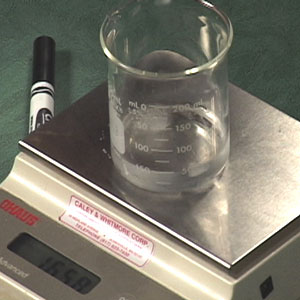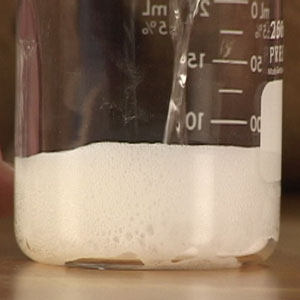Join us for conversations that inspire, recognize, and encourage innovation and best practices in the education profession.
Available on Apple Podcasts, Spotify, Google Podcasts, and more.
Look for the following topics in the video, indicated by the ![]() onscreen icon, and click below to learn more.
onscreen icon, and click below to learn more.
 Mass-Energy Conservation |
 Evaporation vs. Boiling
|

Vinegar is poured into a beaker containing baking soda.
The fact that certain measurable quantities are “conserved” is one of the most powerful ideas in physical science. It is useful because it is one of the major ways to make quantitative predictions about the changes that take place so often in the real world. For example, we know from the video that, if we combine 45 grams of vinegar and five grams of baking soda in a closed system, the resultant carbon dioxide and water will weigh 50 grams, even if we can’t see them. This is the principle of conservation of mass. Many other quantities (like energy, momentum, charge, etc.) are conserved in a “closed system” (i.e., a system that no outside forces or influences can affect).
This concept of conservation of matter evolved as scientists found that it seemed to hold true in every situation where it could be tested — e.g., if you capture all the water vapor generated from boiling water and find a way to measure its mass, you find it is the same as the original mass of the water.
The situations that caused people to question this idea were the ones that didn’t seem to be “normal.” In particular, when it became possible to weigh an individual proton or neutron, the component particles that make up the nuclei of all atoms, it was found that adding the mass of six protons and six neutrons resulted in more mass than one carbon nucleus, which is made of six protons and six neutrons stuck together. The sum of the mass of 6 protons and 6 neutrons is 12.0956 atomic mass units (amu), while the mass of the carbon nucleus is 12.0000 amu. Therefore, the mass of a carbon nucleus is less than the sum of its parts.
Because the principle of conservation of matter is so valuable, scientists were hesitant to try to start from scratch to explain this phenomenon of “lost” mass. Eventually, it was proposed that since these particles were bound together, some of the mass had been used in “binding” the particles together. It is this “binding energy” that is given by Einstein’s famous equation E = mc^2, which says that the amount of energy you get by completely converting mass (m) can be predicted by multiplying it by the speed of light (c) squared.
This idea has been tested in many different contexts. Thus, we must refine our principle of conservation of mass to be one of conservation of mass and energy because, under certain extreme conditions, they can transform into each other.
In nuclear power plants, in a process called nuclear fission, the nuclei of uranium atoms are bombarded by neutrons and split into the nuclei of several smaller atoms. The combined weight of these smaller atoms is less than the weight of the original uranium atoms. This loss of mass has, in fact, been released as energy. This energy is sometimes in the form of photons of high-frequency light, known as “gamma rays.”
The fission of one gram of uranium releases the same amount of energy as burning three tons of coal or 600 gallons of fuel oil.
In the video, vacuum engineer Bob Childs is shown working at the MIT Plasma and Fusion Center. In nuclear fusion, particles of a lighter element are transformed into new particles of a heavier element. Fusion also releases energy when these particles are bound together. If you add all the mass and energy that’s around before and after either nuclear fusion or fission, you’ll find that the totals come out to be exactly the same.
Changes where the loss of mass is significant, like the above examples, typically happen only in the extreme conditions of nuclear reactors or inside stars, like the Sun. However, any time we change the way particles are arranged, we are binding them in a different way, so very small amounts of binding energy are still being used. Therefore, the water vapor in the above example would weigh slightly more than the 15 grams of our original water because there is slightly less energy in the more “loosely bound” water vapor.
Typically, this difference is so small as to be undetectable, so the principle of conservation of matter is good enough for everyday situations. (In fact, in any physical change, the difference in mass is about one part in a billion, which is smaller than can be measured by even the most sensitive balances.)
At first glance, it would seem that evaporation and boiling might be the same process, because both start with a liquid and end up with a gas. However, there are some important macroscopic and microscopic differences that help make the distinction.

Boiling water.
Evaporation happens only at the surface of a liquid and occurs at any temperature (so long as the substance is a liquid at that temperature). However, as most people are aware, liquids evaporates faster at a higher temperature.
Boiling, on the other hand, happens throughout the bulk of a liquid, usually starting from some site on the inside of the container and rising in a bubble to the surface. It only happens when the temperature is above the boiling point of that substance.
Boiling occurs when the average motion of particles is fast enough to overcome the forces holding them close together. This happens evenly throughout a boiling liquid because the temperature is uniform throughout.
Evaporation happens for the following two reasons:
In the cases of both boiling and evaporation, the force between two particles is always present. The greater the space between the particles becomes, however, the weaker the force is between them. To break the bond between two particles, one particle has to be moving fast enough to overcome the pull of the other, until it gets so far away that pull is diminished. An analogy would be if you tried to jump off the Earth: we cannot jump fast enough to get to where Earth’s gravity has less pull, but a rocket can.